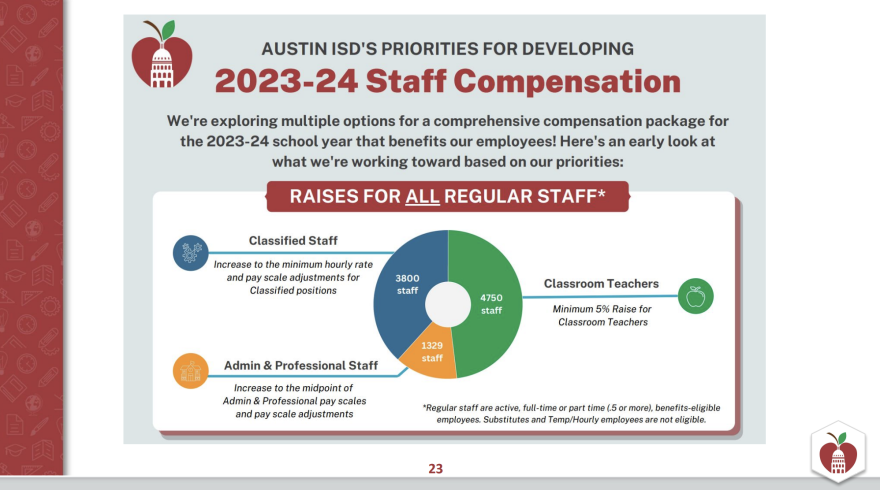Austin ISD’s Chief Financial Officer Ed Ramos told school board members Thursday that compensation is the number one priority for the district’s 2023-2024 budget.
“Hiring teachers and keeping them in the district is a challenge not only for Austin ISD, but for districts across the state,” he said.
Austin ISD’s goal is to raise classroom teacher pay by at least 5%. Ramos said the increase is key to compete with surrounding Central Texas school districts. He told AISD trustees that while the district salaries are competitive for teachers with zero to five years of experience, salaries for veteran teachers are lagging. He is especially focused on getting Austin ISD’s pay on par with Hays CISD, one of the highest paying districts in the area.
“They made a very aggressive move last year,” he said. “Our intent is to catch that district within the next two years and actually be the highest paying district in Central Texas within the next two years.”

Austin ISD administrators are also proposing raises for classified staff as well as administrative and professional staff. About 87% of the district’s budget is for employee pay.
Brandi Hosack, the district’s chief of human capital, said it’s vital to create the best possible compensation package but there could be tough decisions ahead to achieve that.
“There is a finite number of dollars and an infinite amount of need,” she said.
Compensation is also a top priority for Austin ISD school board members, many of whom have been teachers themselves. Board Vice President Kevin Foster, who represents District 3, said administrators need to think outside of the box to significantly raise pay.
“I’m not interested in a 5% raise for teachers. I’m interested in a thorough reimagining that matches what some places around the country have done,” he said.
He said, ideally, new teachers would make at least $70,000. The current starting salary for Austin ISD teachers is just over $52,000 — not including bonuses and other stipends.
Trustee Kathryn Whitley Chu, who represents District 4, formerly taught in Austin ISD and Round Rock ISD. She urged district officials to look at other urban districts beyond Central Texas to determine what competitive teacher salaries would be.
“We are essentially training teachers to leave our district and go somewhere else and be compensated more,” she said.

The trustee for District 6, Andrew Gonzales, was an Austin ISD teacher who resigned after the 2021-2022 school year. He said while compensation is crucial, the district should not lose sight of providing other types of support to teachers that make it possible for them to do their jobs.
“I just would not like us to get myopic about increasing compensation as the answer to everything,” he said.
Other top priorities for the district and school board members include more funding for special education, multilingual education and mental health.
Ramos said Austin ISD is in the early stages of developing its budget for the next school year and is holding both virtual and in-person events through early March to get feedback on what the funding priorities should be.
He also pointed out that the budget is based on current state law, but the Texas Legislature could make changes during the 88th session that impact their calculations.
“We do know that the state is coming into this legislative session with a $33 billion surplus,” Ramos said. “So, there are opportunities for education funding, and so we are again going to be very active in advocating for some of those dollars to be used to increase education funding.”
Democratic lawmakers have filed bills to fund public schools based on enrollment, rather than attendance. Other bills seek to raise per student funding, known as the basic allotment. Both of these measures would increase state funding for public education. Increasing the basic allotment would reduce Austin ISD’s payment into the recapture system.
The recapture system, also known as Robin Hood, takes money from property-wealthy school districts and distributes it to districts that can’t raise as much money through property taxes. Austin ISD has by far the highest recapture payment of any school district in Texas. Ramos said, without changes, that payment will continue to rise because enrollment in Austin ISD schools is flat while property values continue to rise. The district projects 54.5% of revenues raised through the maintenance and operation tax rate will be subject to recapture.
Ramos said last year Austin ISD sent $761 million dollars to the state. The recapture payment this year is expected to be $846 million.









